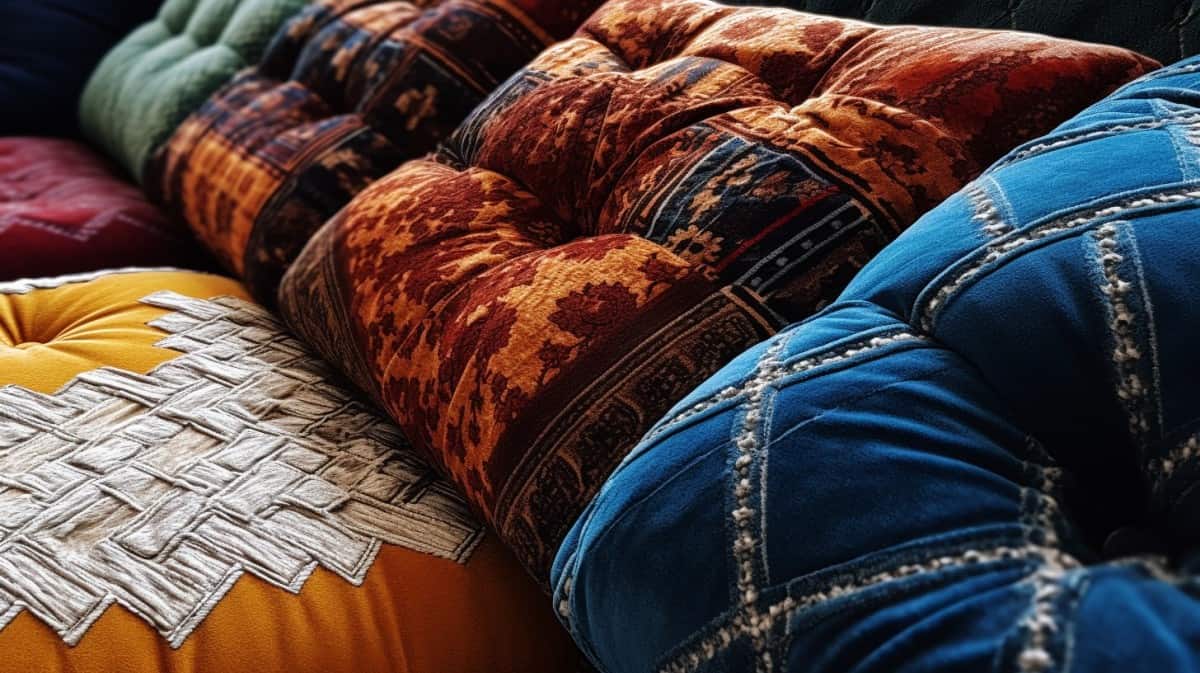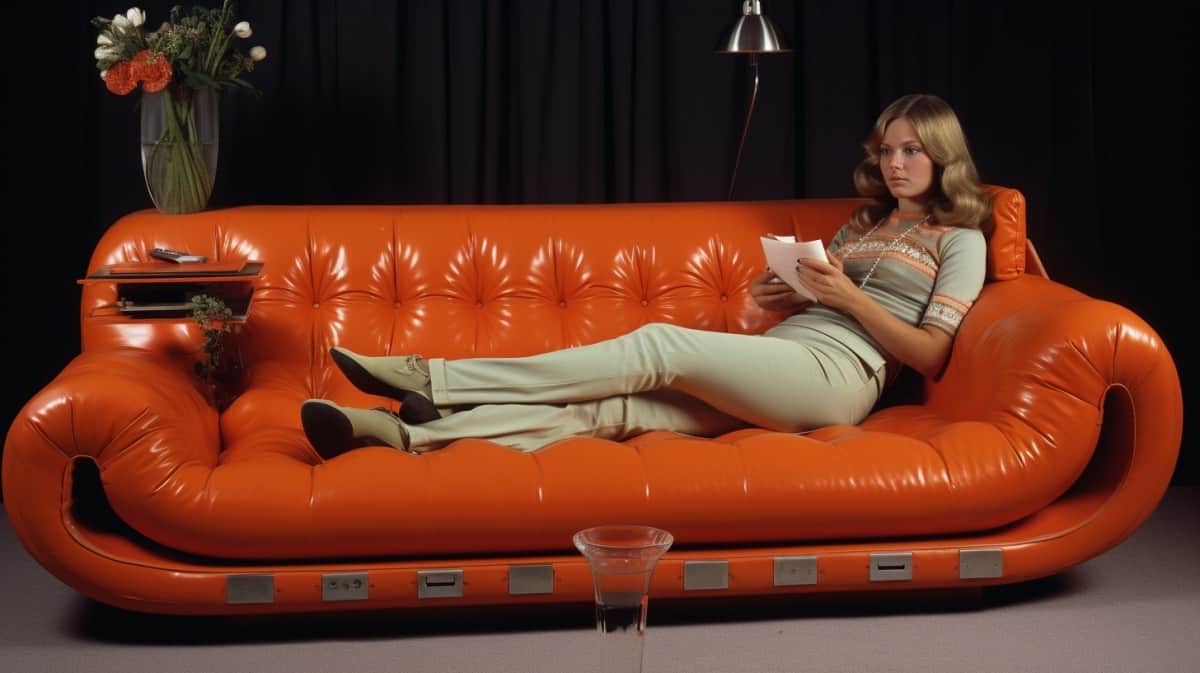When it comes to finding your ideal sofa color, you’ve got nothing to hues (sorry, couldn’t help ourselves). But what if you’re struggling to figure out which color best suits your space? This guide will help you pick out the perfect sofa color for your space.
Which sofa color is the best?
When it comes to picking couch colors for your living room sets, there’s no tried and true hue that will always be right for you (sorry, we’ve been reading lots of Dr. Seuss recently). But there are absolutely some options that have proven to be superstars for living room design. These color options are a great starting point.
- Neutral Nuance: Beige, gray, and white reign as timeless classics that effortlessly adapt to any decor style. Their versatility makes them a safe bet for various aesthetics.
- Bold and Vibrant: If you’re feeling adventurous, consider deeper hues like navy blue, rich green, or even a passionate red. These shades can infuse your space with personality and flair.
- Harmonious Integration: Before you make a choice, take a moment to consider your room’s existing color palette and overall ambiance. Opt for a sofa color that harmonizes with your decor.
- Patterns and Textures: Don’t shy away from patterns and textures. They can add depth and visual interest to your sofa. Think about geometric designs, florals, or even playful prints.
When it comes to sofa colors, there’s no one-size-fits-all answer. Your sofa color should reflect your personal style and enhance the atmosphere of your living space.
What is the most popular color for a couch?
Remember, it’s not a popularity contest. What’s that? Oh, in this case it actually is. So what is the most popular couch color? Is it a green velvet sofa? A beige couch? Find out!
- Neutral Neutrality: The reigning champion of couch colors is the versatile neutral palette. Shades like beige, gray, and taupe are the go-to choices, seamlessly blending with various decor styles and acting as a canvas for pops of color.
- Bold and Beautiful: While neutrals hold the crown, bold colors like navy, emerald, and burgundy are gaining ground. These hues add character and a touch of drama to any room, making your couch a centerpiece of conversation.
- Classic Black: Black sofas exude elegance and modernity. They’re the perfect backdrop for vibrant cushions and decorative accents, creating a timeless and sophisticated ambiance.
- Subtle Blues: Blue tones, from soothing sky to deep navy, bring a sense of calm and tranquility to your space. They pair well with a range of color schemes, making them a popular choice for many homes.
So, whether you’re drawn to neutrals for their adaptability, bold colors for their statement-making prowess, or classic options that stand the test of time, the most popular color for a couch ultimately depends on your personal style and the atmosphere you want to create in your living area.
What is the most popular color for a leather sofa?

Leather sofas exude timeless appeal, and certain colors have consistently stolen the spotlight over the years. Here’s a glimpse into the hues that often take center stage for leather sofas:
- Classic Charcoal: A deep charcoal or black leather sofa is a perennial favorite. It’s versatile, sleek, and adds a sense of sophistication to any space.
- Rich Cognac: Cognac or warm brown leather exudes a cozy and inviting vibe. It’s a nod to vintage aesthetics and can add warmth to both traditional and modern settings.
- Timeless Tan: A neutral tan leather sofa is a versatile choice that complements various color schemes. It brings a sense of understated elegance and is less prone to showing wear over time. We personally love the look of a dune sofa, as long as it leaves the sand in the desert.
- Ravishing Rustic Red: For those looking to make a bold statement, a rustic red leather sofa can add a pop of color and character. It’s a daring choice that can become the focal point of your living area.
These popular leather sofa colors offer a range of styles, allowing you to choose the shade that resonates most with your personal taste and complements your overall décor.
Is beige a good color for a sofa?
A beige couch is versatile and timeless. And it comes with a bouquet of benefits that make it a winner in the world of interior design:
- Neutral Charm: Beige falls within the neutral color spectrum, which means it plays well with a wide range of other colors. Whether your décor leans towards bold or subdued, beige can seamlessly blend in.
- Enhanced Flexibility: Beige sofas offer the flexibility to switch up your interior style over time. You can easily change the look of your space by updating accessories like pillows and throws without worrying about clashing colors.
- Light and Airy: Lighter shades of beige can create an airy and open feel in your living area. If you’re aiming for a serene and inviting atmosphere, beige is an excellent choice.
- Timeless Appeal: Beige doesn’t easily go out of style. It’s a classic hue that withstands changing trends, making it a safe bet if you’re looking for a sofa that will stay relevant for years to come.
So, whether you’re aiming for a blank canvas to experiment with various décor elements or seeking a sofa that can gracefully transition through different design phases, beige is a color that can harmonize with your style and stand the test of time.
What color couch goes with cream walls?
Cream loves to be part of a pair. Cookies and cream, anyone? Similarly, cream walls provide a soothing and neutral backdrop for your space, and choosing the right color couch can enhance the overall aesthetic. Here are a few stylish options that pair well with cream walls:
- Elegant Grey: A gray couch creates a sophisticated and calming atmosphere when paired with cream walls. Lighter shades of gray can also add depth without overwhelming the space.
- Subtle Beige: A beige or light tan couch harmonizes seamlessly with cream walls, creating a serene and cohesive look that exudes warmth.
- Soft Blue: Soft blue tones, such as light aqua or pale blue-gray, can bring a touch of color without overpowering the cream walls, resulting in a serene and coastal-inspired ambiance.
- Warm Earth Tones: Earthy hues like olive green, terracotta, or muted rust can add a cozy and inviting feel, creating a natural connection with the cream walls.
The key is to opt for colors that complement rather than compete with the cream walls, while also allowing your couch to stand out.
What is the most popular sofa color in 2023?

Keeping up with the Joneses? Then you’ll want to make sure you know what the hottest sofa colors are for 2023. But what about 2022? It’s ancient history! Here are some colors that currently wear the crown below and be sure to check out our post on couches in Pantone’s Color of the Year 2023: Peach Fuzz!
- Earthy Elegance: Earthy tones like terracotta, rust, and olive green are taking the spotlight. These warm and natural hues infuse a sense of coziness and connection with the outdoors.
- Rich Jewel Tones: Deep jewel tones such as sapphire blue, emerald green, and amethyst purple are making waves. These opulent shades add depth and opulence to your space.
- Blushing Beauty: Soft blush pink is still holding its ground in 2023 because this delicate hue brings a touch of romance and sophistication to your living area.
- Muted Monochromes: Monochromatic color schemes with varying shades of a single color are gaining popularity. These subtle and understated combinations create a harmonious and calming atmosphere.
In the ever-evolving world of interior design, these on-trend colors are set to make a statement in 2023, allowing you to infuse your living space with a touch of contemporary flair.
What couch colors are in style?
Popularity and style aren’t the same thing. You can be stylish and still be unpopular (don’t ask us how we know). So if you want to know the most stylish colors for your sofa, we’ve got the scoop.
- Rich Emerald: This lush green hue brings a sense of nature indoors, adding a touch of opulence and vibrancy to your space.
- Classic Navy: Navy blue is a timeless choice that exudes sophistication and versatility, effortlessly adapting to various decor styles.
- Blush Pink: Soft and charming, blush pink injects a delicate yet modern flair into your room, offering a subtle pop of color.
- Deep Burgundy: With its warm and luxurious aura, deep burgundy brings depth and coziness to your living area, making a bold statement.
These colors reflect the current trends while offering a fresh twist to your couch selection, allowing you to infuse your living space with personality and style.
What color couch goes with light grey walls?
Good news! If you have light grey walls then you have plenty of amazing options for couch color. Here are a few to consider.
- Soft Mint Green: This serene and refreshing shade adds a touch of tranquility, creating a soothing and balanced ambiance.
- Dusty Rose: Combining the subtlety of grey with a delicate rosy hue can create a sophisticated and inviting contrast.
- Crisp White: Opting for a white couch against light grey walls offers a clean and timeless look, accentuating the modern aesthetics.
- Charcoal Grey: Pairing light grey walls with slightly darker charcoal grey couch creates an elegant and cohesive color scheme.
These couch color choices can help you craft a space that feels inviting, balanced, and stylish, enhancing the overall visual appeal of your living area.
Is a darker or lighter couch better?
The eternal debate between darker and lighter couch colors is a fun journey of personal preference and style. Let’s shed some light on both options.
- Darker Delights: A darker couch color can infuse depth and richness into your space. It’s excellent at hiding stains and wear, making it a practical choice for busy households. Plus, it can create a cozy and intimate atmosphere.
- Lighter Elegance: On the other hand, a lighter couch color can open up a room, creating an airy and spacious feel. While it might require a bit more maintenance, it exudes a timeless and sophisticated charm.
Choosing between the two depends on your lifestyle, existing decor, and the ambiance you want to create. Embrace the magic of contrasts and complement, and you’ll find the perfect couch color that speaks to your heart and style.
What color couch makes a room look bigger?
The color of your couch can work wonders in creating the illusion of a larger space, but certain colors can really make your space feel expansive.
- Cool and Light: Opting for lighter shades like soft neutrals, pastels, or cool grays can reflect more light and make your room appear more open. These colors have a way of creating an airy and inviting atmosphere.
- Monochromatic Magic: Choosing a couch color that matches or closely complements the wall color can blur the visual boundaries, making the room feel less confined. This monochromatic approach creates a seamless flow.
- Subtle Contrasts: Introducing gentle contrasts between your couch color and the wall can add depth without closing in the space. Think about pairing light-colored walls with a slightly darker couch to create a balanced contrast.
- Minimal Patterns: If patterns are your thing, opt for subtle and small-scale designs. They can add character to your couch without overwhelming the room’s visual space.
Remember, the color of your couch is just one piece of the puzzle. Clever furniture placement, the use of mirrors, and maximizing natural light can all contribute to creating a room that feels larger and more inviting.
Is a light colored couch a good idea?
A light colored couch is very appealing, but it can have its downsides. Factors such as having young kids, pets, or a daily bottle of red wine intake can all make light colors a risky situation for your sofa.
- Airy Ambiance: Light-colored couches, such as soft neutrals or pastels, have a magical way of opening up a room. They reflect more light, creating an airy and spacious ambiance that can make your space feel larger and more inviting.
- Versatile Canvas: Light hues provide a versatile canvas that effortlessly pairs with a wide range of decor styles and colors. This adaptability allows you to experiment with various accent pieces and accessories.
- Serene and Soothing: Light colors often evoke a sense of calm and tranquility. A light-colored couch can create a soothing and relaxing atmosphere, making your living area a cozy retreat.
- Easy Elegance: Light-colored couches exude a timeless and elegant aesthetic. Whether your style is modern, traditional, or somewhere in between, a light-colored couch can seamlessly integrate into your decor.
Remember, while a light-colored couch has many advantages, it’s essential to consider your lifestyle and any potential challenges, like maintaining its cleanliness. With proper care and the right decor choices, a light-colored couch can be a stunning centerpiece in your living space.
What are the benefits of a dark couch?
A dark-colored couch can bring a touch of drama and sophistication to your living space, but it can also be stifling. So is it a smart choice?
- Bold Statement: Dark colors like deep blues, rich greens, or elegant blacks create a bold and eye-catching focal point in your room. They add a sense of depth and character that can instantly elevate your decor.
- Stylish Contrast: Dark couches can create a striking contrast when paired with light-colored walls, rugs, and other furnishings. This dynamic interplay adds visual interest and depth to your space.
- Stain Concealment: Dark colors are often more forgiving when it comes to concealing stains and spills. This can be especially advantageous if you have pets or young children, offering peace of mind without sacrificing style.
- Cozy and Intimate: Dark-colored couches can create a cozy and intimate atmosphere, perfect for relaxing evenings or gatherings with friends and family. They can help to create a snug and inviting space.
- Versatile Palette: Dark hues provide a versatile backdrop for accessorizing and styling. They can accommodate a wide range of color schemes, allowing you to change up your decor without needing to switch out the couch.
From making a powerful design statement to offering practical benefits, a dark-colored couch can add depth and allure to your living space, inviting you to unwind and enjoy its cozy embrace.
Should all of my furniture be the same color?
While there’s no hard and fast rule about matching all your furniture to the same color, there are a few tips to consider when deciding on a cohesive color scheme for your space:
- Harmonious Palette: Opting for a harmonious color palette can create a sense of unity and balance in your room. This doesn’t mean everything needs to be the exact same color, but choosing colors that complement each other can make your space feel pulled together.
- Variety with Consistency: Mixing different colors can add visual interest and prevent your space from looking monotonous. However, maintaining consistency in tone or style can help create a cohesive look. For example, mixing different shades of blue with neutral tones can provide variation while maintaining a unified feel.
- Focal Point: Introducing a standout piece of furniture in a different color can serve as a focal point and add an element of surprise to your room. This creates contrast and draws attention to specific areas or pieces.
- Texture and Pattern: Incorporating various textures and patterns can add depth and dimension to your space. These elements can help tie together different furniture pieces even if they’re not all the same color.
- Personal Style: Ultimately, your personal style and preferences should guide your decisions. So if you love the idea of a monochromatic scheme, go for it! But if you’re drawn to a mix of colors and patterns, that works too. Your space should reflect your personality and make you feel comfortable.
In the world of interior design, there’s no one-size-fits-all approach. The key is finding a balance between cohesion and individuality that resonates with you and creates a space you love to inhabit.
How to choose a sofa color for your living room?

Choosing the perfect sofa color for your living room is a delightful journey that can infuse your space with personality and charm. Whether you choose the most popular colors or the ones that speak to you, we’ll help you find a color you love.
- Space Evaluation: Take a close look at your living room’s existing color palette, including wall colors, flooring, and other furniture. This will give you a starting point for coordinating your sofa color.
- Mood and Style: Consider the mood you want to evoke in your living room. Do you prefer a cozy, serene ambiance or a bold and energetic vibe? Your sofa color can play a significant role in setting the tone.
- Contrast and Harmony: Opt for a color that either contrasts with or harmonizes well with your room’s existing colors. So if you have neutral walls, a vibrant sofa can make a striking statement. On the other hand, a sofa in a complementary color can create a harmonious look.
- Test It Out: Before committing, gather swatches or samples of the sofa color you’re considering. Place them in different parts of the room to see how the color interacts with various lighting conditions throughout the day.
Choosing a sofa color is a creative endeavor that lets you infuse your personal flair into your living space. With a blend of practicality and artistic intuition, you’re on your way to finding the perfect sofa color that speaks to you and complements your home’s style.
Are grey couches in style?
Grey couches continue to be a stylish and versatile choice for modern interiors. These neutral darlings have solidified their place in the design world, and here’s why.
- Timeless Neutrality: Grey is the chameleon of colors because it effortlessly complements a wide range of design styles and color schemes. Whether your décor leans minimalist, industrial, or even eclectic, a grey couch can seamlessly adapt.
- Variety of Shades: Grey isn’t just one shade—it’s a spectrum! From light and airy to deep and charcoal, there’s a grey tone for every preference. Because of this variety, it allows you to tailor your couch to your room’s mood and style.
- Backdrop for Accents: A grey couch provides the perfect canvas for adding pops of color through throw pillows, blankets, and décor items. This flexibility lets you switch up your accent colors whenever the mood strikes.
- Elegance and Serenity: Grey exudes a sense of understated elegance and tranquility. It can create a serene atmosphere in your living space, making it an ideal choice for creating a calming oasis.
Whether you’re a fan of minimalist aesthetics, dramatic contrasts, or eclectic flair, a grey couch is a timeless investment that aligns with various design trends.
What is the best color of sofa for a small living room?
When it comes to choosing a sofa color for a small living room, strategic choices can make your space feel larger and more inviting. Here’s how to nail it.
- Light and Airy Hues: Opt for light colors like soft beige, light grey, or pastel tones. Because these shades reflect more light, they create an illusion of openness and space.
- Monochrome Your Home: Consider a sofa color that matches or closely complements your wall color. This monochromatic approach reduces visual clutter and helps your sofa blend seamlessly into the room.
- Keep It In Neutral: Neutrals, such as ivory, taupe, or light tan, work wonders in a small living room. These tones create a versatile backdrop that won’t overwhelm the space.
- Subtlety Is Key: If you’re a fan of patterns, choose ones that are subtle and small-scale. This prevents the sofa from becoming a dominant visual element, allowing other features of the room to shine.
So if you embrace these tips, you can select a sofa color that enhances the perception of space, promotes a harmonious atmosphere, and makes your small living room feel cozy yet open.
What color sofa with white walls?
Much like grey walls, white walls afford a great opportunity for you to let your personal expression shine. Because white is essentially a blank canvas, there are no real wrong answers. But, as with most things, there are some color choices that will look better than others.
- It Really Is Black and White: A dark-colored sofa, such as navy blue or charcoal grey, can create a striking contrast against white walls, adding depth and drama to the room.
- Be Like Switzerland and Stay Neutral: Opt for a neutral sofa color, like beige, light grey, or soft taupe. These tones complement white walls, exuding a timeless and elegant vibe.
- Vivid Accents: A colorful sofa, such as emerald green or mustard yellow, can pop against white walls, infusing energy and personality into the space.
- Same Is The Name of the Game: Choose a sofa color that is within the same color family as your white walls. This monochromatic approach creates a seamless and sophisticated look.
And there you have it! Because of white’s wonderful flexibility, you can have lots of fun picking your favorite sofa color.
Can you have 2 different color sofas in a living room?
Mixing and matching sofa colors in your living room can result in a dynamic and visually appealing space, which can really create a personalized look. But does that make it OK to have two different sofa colors? Or do you need to banish one to the bedroom so that it becomes a couch bedroom couch?
- Color Harmony: Choose sofa colors that complement each other or belong to the same color family. This creates a cohesive and harmonious look that ties the room together.
- Contrasting Textures: If you’re going for two different sofa colors, consider using sofas with similar textures or materials. This adds consistency and prevents the space from feeling disjointed.
- Accent Pillows: Use coordinating accent pillows or throws on each sofa to bridge the color gap and create a unified design.
- Balance and Proportion: Pay attention to the size and scale of each sofa. Make sure they’re balanced within the room, and consider arranging them symmetrically for a polished look.
By thoughtfully selecting sofa colors, textures, and accessories, you can successfully incorporate two different colored sofas into your living room, resulting in a unique and inviting environment that reflects your personal style.

